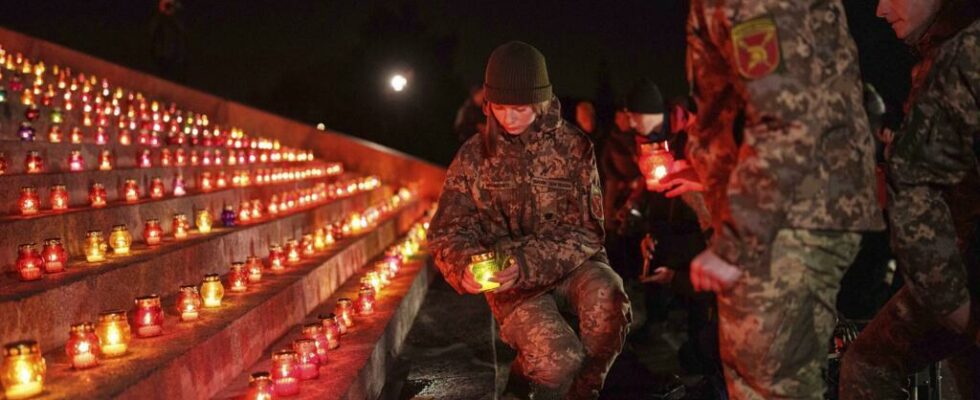At war against the Russian army since February 24, 2022, Ukraine commemorates the thousandth day of the conflict between it and Moscow’s forces, this Wednesday, November 20. On this very symbolic day, what is the state of mind of Ukrainians who are living under bombings? How much of Ukrainian territory did Russia manage to conquer? And what exactly is the balance of power on the ground? RFI takes stock.
6 mins
with our correspondent in kyiv, Emmanuelle Chaze and our correspondent in Geneva, Jeremy Lanche
For Ukrainians, these 1,000 days after the large-scale invasion of their country by the Russia are reflected, first of all, by the omnipresence of war in their daily lives. Walking the streets of kyiv is enough to understand that nothing is normal there. “ Here, in the city center, it’s dark, many lights no longer work because there are power outages, and many people walk with their phones on like flashlights so as not to fall. “, thus illustrates Emma, a passerby.
“ Much infrastructure has certainly been rebuilt, but it is not enough. My concern is that if [les forces russes] attack new energy production plants, we will then clearly reach a tipping point. We would see even more population movements, not only in Ukraine itself but also abroad “, worries Matthias Schmale, the coordinator of UN humanitarian operations in this regard. Ukrainewhile winter is coming and Ukrainian energy capacities are at their lowest.
Also readUkraine: Russia carries out massive attacks on the country’s fragile energy network
Added to the material difficulties of daily life is the threat of bombings
If millions of Ukrainians live far from the front line, the consequences of the war still affect them, too, on a daily basis. “Many of my close friends are trying to disconnect, and they prefer to sit at home, play video games or go to work from 7 a.m. to 9 p.m. just to escape somewhere, to escape reality,” says Maria Bindiuk who is a bookstore. Especially since the material difficulties of daily life are added to the threats posed by Russian bombings using hovering bombs, drones or missiles. In kyiv, since September, sirens have sounded every night while the south of the country is not spared either, far from it. The regions of Odessa, Mykolaiv and Kherson are currently those most often targeted by Russian drones.
Also readUkraine: at least one dead after “massive” Russian attack in Odessa
According to Ukraine, Russia has launched more than 2 000 in the month of Octoberalmost twice as much as in September. Mostly Iranian-made Shahed kamikaze drones. Drones that only strike military targets. “ More and more civilians are telling me that they have been targeted by drones. It’s not just a feeling, they told me about it in detail, how the drones follow them… Because the principle of the drone is that you don’t know if it’s there to monitor you or for you tackle. Just the noise it makes in the air above you is clearly psychological terror », Relates Matthias Schmale. Unfortunately, the machines do not seem ready to leave the Ukrainian skies: recently, North Korea actually announced that it would mass produce explosive drones presumably on behalf of Russia.
On a purely military level, the latter occupies, to date, a little less than 20% of Ukrainian territory, or 600,000 km2, if we include the Crimean peninsula. The fighting takes place mainly on two main fronts. The first is in Donbass, on a line approximately 1,000 kilometers long from Kherson in the south to the Russian border, east of Kharkiv. With sometimes up to five lines of defense protecting it, it is made almost impassable by minefields which cover, to date, no less than 200,000 km2.
Losses, a well-kept secret on both sides
The other major front is located on the other side of the Ukrainian border, in Russia. This is the Kursk pocket taken last August by the Ukrainians. If, since then, kyiv’s forces have lost 400 of the 1000 km2 that they had managed to conquer there, their incursion into Russian territory allows them to take the fight to the adversary and pose a threat to the Russian system. The fact remains that, in one case as in the other, the progress remains very weak and is more of a nibble because after two and a half years of war, the situation has rather stabilized on the Ukrainian side following a real period of crisis, when the Ammunition provided by American aid no longer arrived. And if the Ukrainian army also has a problem of turnover and recruitment, the Russians are exposed to the same difficulties, which is why they decided to call on North Korean soldiers.
Also readOn the thousandth day of Russian aggression, Ukraine strikes Russia with American ATACMS missiles
The real difference to Moscow’s advantage lies in its deeper strategic reservoir, a handicap that kyiv could partly compensate for, despite everything, with the American authorization granted this weekend to strike Russian territory with long-range ATACMS missiles. This turning point will certainly not upset the balance of the war but should at least allow the Ukrainians to slow down the Russian dynamic and offer themselves a salutary respite.
Finally, regarding the question of losses, it remains, on both sides, a well-kept secret. In mid-September, however, American sources estimated the number of Russian and Ukrainian dead and wounded at more than a million, with losses twice as high on the Russian side: 200,000 dead and 400,000 wounded compared to 80,000 dead and 400,000 injured on the Ukrainian side since the start of the war in February 2022. A war that on this symbolic day of 1,000 days, Ukrainians like to remind us that it began for them in 2014, exactly 3,926 years ago days, from the first Russian territorial violations in Crimea and that, since then, Russian aggression has only gotten worse.
Also readATACMS missiles: what benefits are expected for Ukraine after the American green light?
